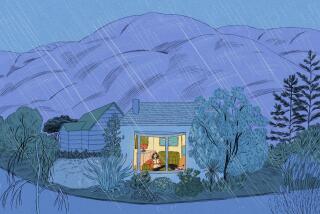Filling the Empty Hours Between Getting There and Being There
- Share via
This is what I do when I go on a trip:
I wake up, get ready and wait for the taxi.
The taxi arrives, followed by the trip to the airport, which is really a wait during which the scenery changes. At the airport, I wait to check in and to go through security, then wait some more at the gate for my row to be called.
On the plane, I wait for takeoff, wait for the meal service and wait for the flight to land. Then I wait for the “fasten seat belt” light to go off and wait in the aisle of the aircraft for the door to open.
Then I wait for my luggage and for another taxi. By the time I reach my hotel, I couldn’t wait another minute for anything, not even the Nobel Prize.
We like to think of a trip as synonymous with having adventures and seeing remarkable things, but I wonder how much of it really comes down to waiting. It’s almost enough to stop you from traveling, but that would never do. So I’m working on ways to take the pain out of killing time on the road.
I try to wait patiently and decorously, like other grown-ups. And I always remember a lesson my mother taught me about how to put empty hours to practical use. At the time, I was an adolescent insomniac. “If you can’t sleep,” Mom told me, “get up and do some ironing.”
But where was I supposed to find an ironing board at the Shanghai airport? On a trip back from China four years ago, I had arrived at the airport early because I was eager to get home, and I waited with other passengers at the gate for several hours. Then our passports were confiscated, and we were herded onto a bus that took us to a nearby hotel. There we were given rooms and dinner, but no information about the flight. Three or four more hours passed before we were summoned back to the airport. The plane finally took off nine hours late for a 20-hour flight to New York.
Three years ago I had another hideous travel experience right out of Samuel Beckett’s “Waiting for Godot.” I was on the Jammu Mail train from New Delhi, ultimately going to Dharmsala in the Indian Himalayas. A derailment delayed the train eight hours. The bathrooms grew unspeakably filthy, and I ran out of bottled water. On my lap I had a book of essays by the Dalai Lama, which I searched for some kernel of wisdom about how to quell the misery of waiting.
Later I found it in “Wherever You Go There You Are” (Hyperion, 1994), by Buddhist-inspired meditation teacher Jon Kabat-Zinn. “In every moment, we find ourselves at the crossroad of here and now,” Kabat-Zinn says in the book’s introduction. But he goes on to say: “It often seems as if we are preoccupied with ... a future that hasn’t arrived yet. We look for some place else to stand, where we hope things will be better.” According to Kabat-Zinn and Buddhist sages, part of the pain of existence stems from our inability to live in the moment.
To me, that’s the excruciating part of waiting to get off a train or airplane. I’m standing in the aisle hating the here and now, because I want to get to Paris or the Grand Canyon.
Lately, killing time has become a little more tolerable with the advent of airport shopping malls, salons and even health clubs. I can’t think of a better way to fritter away time between flights than by having my nails done.
My mother thinks that’s frivolous. So I try to pass my time in airports getting things done: making phone calls, organizing myself, writing in my journal, reading guidebooks and learning useful words and phrases in the language of the country I’m going to visit.
I learned from my father that people-watching is another good way to pass time. At a restaurant he’ll point out a couple and ask whether I think they’re happy. I like to people-watch because it tells me subtle things about foreign cultures--the way Indian women adjust their saris and Muslim men can be seen in airport corners praying toward Mecca.
It’s lovely when people-watching evolves into people-meeting. Increasingly, I like to find out where my fellow travelers are going and why, and what they care about. For instance, I once had a deep philosophical discussion with a Hasidic rabbi on a flight from New York to L.A. The wretchedness of my ride on the Jammu Mail was eased by talking to a German woman about her travels by bus, truck and foot.
Best of all, though, is when I manage to while away the time in something that approaches a Buddhist meditative state, watching crowds and scenery pass without really taking them in or thinking about anything. I used to achieve this wonderfully restful way of waiting when I lived in northwest Connecticut and made regular two-hour train commutes to New York City. The train stopped at every little station along the line; people got on and off with their overcoats and briefcases; the seasons unfolded outside the window. I paid no particular attention, but oddly enough I can remember it all. And before I knew it, the train was pulling into Grand Central Station.
Perhaps taking the pain out of waiting really is a matter of living in the moment and realizing its potential to enrich the trip.
More to Read
Sign up for The Wild
We’ll help you find the best places to hike, bike and run, as well as the perfect silent spots for meditation and yoga.
You may occasionally receive promotional content from the Los Angeles Times.






